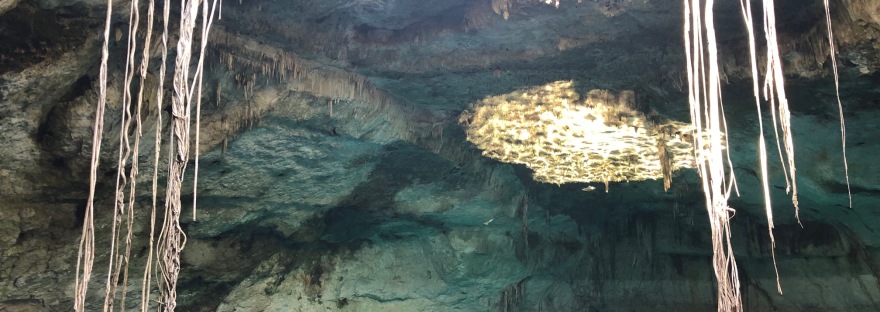This April, I headed to Merida, the capital of the Mexican state of Yucatan to get my advanced scuba license in the cenotes of the region.

I started my trip exploring the city of Merida. The downtown or ‘Centro’ as it is called consists of beautiful squares, quaint churches and the majestic central cathedral. Afternoons are oppressively hot but by early evening, the stores open, the street vendors setup their stalls and the squares come alive with dancing, street shows and local students heading out to party. The many cantinas, cafes and bars buzz with tourists and locals alike, live music abounds, and tequila flows freely. I visited the famous La Negrita cantina and ate some amazing local vegetarian food at Amaro to the background of a live musician crooning local tunes. The roadside vendors sell marquesitas, crepes filled with Nutella, caramel or cheese, that left me craving more.
On day 2, my scuba diving journey began. My scuba instructor and I headed to the Nah Yah cenote in the town of Pixyah. The drive was about an hour through mostly well-constructed freeways. When we reached the town of Pixyah, the mud roads began, which our 4WD navigated quite effectively.

On getting there, I was greeted by a rural landscape of shrubbery, teepees, birds and insects. Nestled under a canopy was a small cave opening that gave way to the most magnificent blue body of water. Sunlight pierced through it painting reflections on the walls of the cave. A tiny wooden stairway led us to the foot of the cenote.

It was then that I realized I had no idea what cenotes were, geologically. My instructor explained to me that cenotes are deep, water-filled sinkholes in limestone. They were created when the roof of the underground cavern collapsed due to erosion and seismic activity, exposing the underground network of rivers flowing just beneath the surface of the Yucatan Peninsula. The sinkholes were deemed sacred by the ancient Mayan civilizations residing in the region. Considered gateways to the underworld, they were used as sacrifice grounds for humans, animals and other sacred objects like gold, pottery and incense.

Once we had understood the lay of the land, it was time for the diving to begin. We suited up and drudged down the stairs carrying the heavy tanks and weights, which was no mean feat. Once we were all set, I jumped into the water, marveling at how cold it was despite the persistent heat on the surface.
As we descended the 30m of water to the bed of the cenote, we saw marvelous light patterns through the walls, various rock formations and underwater flora. Shoals of catfish swam across the floor and tiny shrimps made their homes on the darker edges of the rock. The most exciting finds though were the massive skeletons of animals – mainly cows and pigs – and ancient mayan skulls, recognizable by their flattened foreheads. In ancient Mayan civilization, parents flattened the heads of their newborns to make it look more elongated, like an ear of corn, through a process called trepanning.

To complete my diving certification, I did 4 more dives in Nah Yah and other cenotes, all of which were extremely rewarding yet challenging. On finishing my 5 dives and the written exam, I was awarded the advanced scuba diver certification and a once-in-a-lifetime experience to explore the depths of the Yucatan Peninsula!

